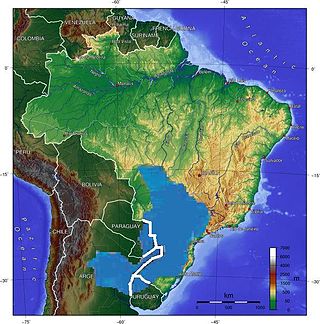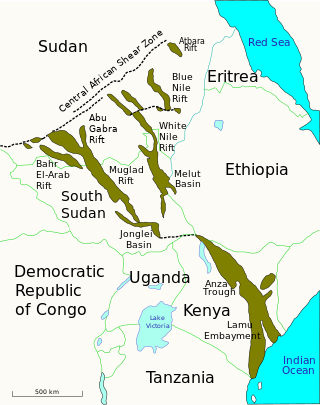Related Research Articles

An aquifer is an underground layer of water-bearing, permeable rock, rock fractures, or unconsolidated materials. Groundwater from aquifers can be extracted using a water well. Water from aquifers can be sustainably harvested through the use of qanats. Aquifers vary greatly in their characteristics. The study of water flow in aquifers and the characterization of aquifers is called hydrogeology. Related terms include aquitard, which is a bed of low permeability along an aquifer, and aquiclude, which is a solid, impermeable area underlying or overlying an aquifer, the pressure of which could create a confined aquifer. The classification of aquifers is as follows: Saturated versus unsaturated; aquifers versus aquitards; confined versus unconfined; isotropic versus anisotropic; porous, karst, or fractured; transboundary aquifer.

The water table is the upper surface of the zone of saturation. The zone of saturation is where the pores and fractures of the ground are saturated with water. It can also be simply explained as the depth below which the ground is saturated.

Groundwater is the water present beneath Earth's surface in rock and soil pore spaces and in the fractures of rock formations. About 30 percent of all readily available freshwater in the world is groundwater. A unit of rock or an unconsolidated deposit is called an aquifer when it can yield a usable quantity of water. The depth at which soil pore spaces or fractures and voids in rock become completely saturated with water is called the water table. Groundwater is recharged from the surface; it may discharge from the surface naturally at springs and seeps, and can form oases or wetlands. Groundwater is also often withdrawn for agricultural, municipal, and industrial use by constructing and operating extraction wells. The study of the distribution and movement of groundwater is hydrogeology, also called groundwater hydrology.

The Oak Ridges Moraine is an ecologically important geological landform in the Mixedwood Plains of south-central Ontario, Canada. The moraine covers a geographic area of 1,900 square kilometres (730 sq mi) between Caledon and Rice Lake, near Peterborough. One of the most significant landforms in southern Ontario, the moraine gets its name from the rolling hills and river valleys extending 160 km (99 mi) east from the Niagara Escarpment to Rice Lake, formed 12,000 years ago by advancing and retreating glaciers during the last glaciation period. Below the approximately 200 metre thick glacial derived sediments of the moraine lies thick bedrock successions of Precambrian rocks and up to 200 metres of Ordovician aged rock, capped by a regional unconformity of erosion and non-deposition to the Quaternary period. Rivers and lakes scatter the landscape and are important for creating habitat for the rich diversity of species of animals, trees and shrubbery. These are also the supply of fresh water to aquifers in the moraine through complex subterranean connections. Construction development nearby, and with expansion of communities around the moraine in need of potable water, it is a contested site in Ontario, since it stands in the path of major urban development. Conservation of the moraine is thus an important step for keeping aquifers in a safe drinkable condition while also protecting the natural ecosystems surrounding and within the moraine. This region has been subject to multiple decades of scientific research to study the origins of formation, and how early communities used the land. A larger focus currently is how to source potable water without removing the aquifer entirely.

The Southern Laurentian Channel is an ancient underground river in southern Ontario, Canada. The river predates the recent ice ages. The river valley was filled with glacial debris. Water still flows down this old valley—underground. The source of the aquifer is the Georgian Bay, approximately 200 kilometres (120 mi) away.
The Trafalgar Moraine is a geological landform straddling Oakville and Milton in Ontario, Canada. A small portion of the moraine extends into Burlington at Milton's southern border. It is a subtler topological feature than the better-known Oak Ridges Moraine, primarily because it was formed as an end moraine at the terminus of a glacial ice sheet, instead of between two retreating ice lobes. The ice sheet pushed material to form the ridge, which is composed of Halton Till sediment, rich in silt and clay. By contrast, the Oak Ridges Moraine is primarily sand and gravel. The ridge was probably formed during a pause in the retreat of the ice sheet. The moraine covers an area of 892.5 hectares of primarily private land, though a small portion is public.
The Oak Ridges Moraine is a geological landform that runs east-west across south central Ontario, Canada. It developed about 12,000 years ago, during the Wisconsin glaciation in North America. A complex ridge of sedimentary material, the moraine is known to have partially developed under water. The Niagara Escarpment played a key role in forming the moraine in that it acted as a dam for glacial meltwater trapped between it and two ice lobes.
Preliminary research on the hydrology of the Oak Ridges Moraine began in the 1970s, but a broader research effort including the impact of urban development on the aquifer system and Great Lakes water quality was established in 1993. The research locus is the Geological Survey of Canada and the University of Toronto Groundwater Research Group, though other groups have made substantial contributions to this project.

The Edwards Aquifer is one of the most prolific artesian aquifers in the world. Located on the eastern edge of the Edwards Plateau in the U.S. state of Texas, it is the source of drinking water for two million people, and is the primary water supply for agriculture and industry in the aquifer's region. Additionally, the Edwards Aquifer feeds the Comal and San Marcos Springs, provides springflow for recreational and downstream uses in the Nueces, San Antonio, Guadalupe, and San Marcos river basins, and is home to several unique and endangered species.

The Guarani Aquifer, located beneath the surface of Argentina, Brazil, Paraguay, and Uruguay, is the second largest known aquifer system in the world and is an important source of fresh water. Named after the Guarani people, it covers 1,200,000 square kilometres (460,000 sq mi), with a volume of about 40,000 cubic kilometres (9,600 cu mi), a thickness of between 50 metres (160 ft) and 800 metres (2,600 ft) and a maximum depth of about 1,800 metres (5,900 ft). It is estimated to contain about 37,000 cubic kilometres (8,900 cu mi) of water, with a total recharge rate of about 166 km³/year from precipitation. It is said that this vast underground reservoir could supply fresh drinking water to the world for 200 years. However, at closer inspection, if the world population were to stay at an equilibrium of about 6.96 billion, not even taking into account that babies need less water than grown adults, this figure reaches 1600 years, allowing about 9 liters per day per person. Due to an expected shortage of fresh water on a global scale, which environmentalists suggest will become critical in under 20 years, this important natural resource is rapidly becoming politicised, and its control becomes ever more controversial.

Overdrafting is the process of extracting groundwater beyond the equilibrium yield of an aquifer. Groundwater is one of the largest sources of fresh water and is found underground. The primary cause of groundwater depletion is the excessive pumping of groundwater up from underground aquifers.
Groundwater-related subsidence is the subsidence of land resulting from unsustainable groundwater extraction. It is a growing problem in the developing world as cities increase in population and water use, without adequate pumping regulation and enforcement. One estimate has 80% of serious U.S. land subsidence problems associated with the excessive extraction of groundwater, making it a growing problem throughout the world.
The Yarragadee Aquifer is a significant freshwater aquifer located in the south west of Western Australia and predominantly beneath the Swan Coastal Plain west of the Darling Scarp. It has a north–south range from about Geraldton to the south coast, but with a split in the formation south of Perth, Western Australia. The southern part is known as the South West Yarragadee Aquifer.

A well is an excavation or structure created in the ground by digging, driving, or drilling to access liquid resources, usually water. The oldest and most common kind of well is a water well, to access groundwater in underground aquifers. The well water is drawn up by a pump, or using containers, such as buckets or large water bags that are raised mechanically or by hand. Water can also be injected back into the aquifer through the well. Wells were first constructed at least eight thousand years ago and historically vary in construction from a simple scoop in the sediment of a dry watercourse to the qanats of Iran, and the stepwells and sakiehs of India. Placing a lining in the well shaft helps create stability, and linings of wood or wickerwork date back at least as far as the Iron Age.
A buried valley is an ancient river or stream valley that has been filled with glacial or unconsolidated sediment. This sediment is made up of predominantly gravel and sand, with some silt and clay. These types of sediments can often store and transmit large amounts of groundwater and act as a local aquifer.
The Oro Moraine is a glacial moraine in Simcoe County, Ontario, Canada. The moraine covers 141 square kilometres (54 sq mi) north of Barrie, Ontario. The moraine drains into Georgian Bay on Lake Huron, and the smaller Lake Simcoe.
An aquifer, according to the Oxford dictionary is a body of permeable rock that can contain or transmit groundwater. Aquifer Susceptibility is the inherent ability of a formation to accept and transmit liquids. Certain areas of the United States are becoming more reliant on groundwater to meet the needs of the population.
The Calumet Aquifer is an aquifer underlying the land at the extreme southern tip of Lake Michigan. It underlies the northern third of Lake County, Indiana and the northern tenth of Porter County, as well as small parts of LaPorte County and Cook County, Illinois. It is notable chiefly for its high levels of contamination by industrial waste from factories and toxic waste dumps in the Calumet Region. It is bordered to the south by Valparaiso Moraine Aquifer, and to the north by Lake Michigan. It is underlain by a Silurian bedrock aquifer complex.

The geology of Sudan formed primarily in the Precambrian, as igneous and metamorphic crystalline basement rock. Ancient terranes and inliers were intruded with granites, granitoids as well as volcanic rocks. Units of all types were deformed, reactivated, intruded and metamorphosed during the Proterozoic Pan-African orogeny. Dramatic sheet flow erosion prevented almost any sedimentary rocks from forming during the Paleozoic and Mesozoic. From the Mesozoic into the Cenozoic the formation of the Red Sea depression and complex faulting led to massive sediment deposition in some locations and regional volcanism. Sudan has petroleum, chromite, salt, gold, limestone and other natural resources.
Beth L. Parker is a professor at the University of Guelph known for her research on groundwater contaminants and the remediation of groundwater systems.
References
- 1 2 Martin, P.J.; Frind, E.O. (1998). "Modeling a complex multi-aquifer system: the Waterloo Moraine". Ground Water. 6 (4): 679–690. doi:10.1111/j.1745-6584.1998.tb02843.x.
- 1 2 3 "Aquifer Characterization and Capture Zone Delineation for the Region of Waterloo" (PDF). Waterloo Hydrogeologic. Retrieved 2006-10-05.
- ↑ "Protecting Significant Moraines in Waterloo Region" (PDF). Waterloo Region. Retrieved 2006-10-05. Archived January 20, 2011, at the Wayback Machine
- 1 2 "Review of the State of Knowledge for the Waterloo and Paris/Galt Moraines" (PDF). Guelph, Ontario . 2009. Retrieved 2018-12-13.
- 1 2 Burtt, Bob (2003-06-21). "Our Buried Treasure" (PDF). The Record. Archived from the original (PDF) on 2006-11-12. Retrieved 2006-10-05.
- ↑ "Waterloo Moraine Request for Review".
- ↑ "Assessment Report — Road Salts". Environment Canada. 2001-12-01. Retrieved 2006-10-05.